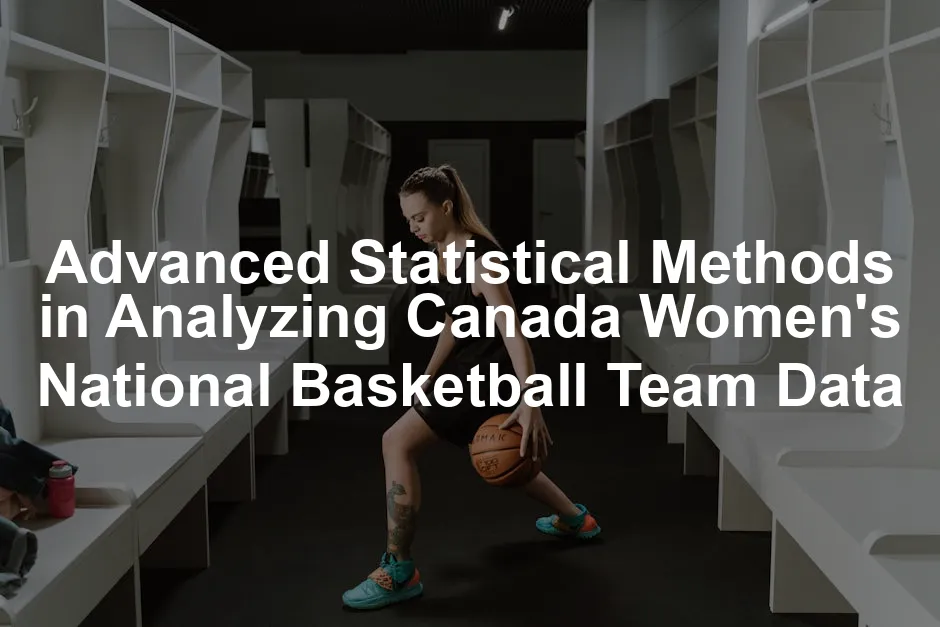Introduction
In the realm of sports analytics, numbers narrate a story beyond mere scorelines. For the Canada Women’s National Basketball Team, advanced statistical methods serve as the keys to unlock performance potential, understand opponents, and refine strategies. These methodologies reshape the narrative of women’s basketball, enhancing competitiveness and offering insightful perspectives.
Imagine the scene: a player makes a critical shot, and the crowd erupts. But behind that moment lies a tapestry of data waiting to be unraveled. Every rebound, assist, and shot is meticulously recorded, analyzed, and transformed into actionable insights. With a sprinkle of humor and a dash of curiosity, let’s journey into the statistical world where numbers become the lifeblood of the game.
The evolution of statistical analysis has transformed how teams approach the sport. Gone are the days of relying solely on traditional metrics like points scored and games won. Today, advanced analytics dive deep into player efficiency, shooting accuracy, and team dynamics. For the Canada Women’s National Basketball Team, this means harnessing data to improve performance and increase visibility.
Key performance indicators (KPIs) have emerged as vital tools in this analytical arsenal. Metrics such as Player Efficiency Rating (PER), shooting percentages, and assist-to-turnover ratios provide a clearer picture of individual and team performance. These indicators not only inform coaching decisions but also help in player development, ultimately leading to improved gameplay.
But it doesn’t stop there! The integration of cutting-edge technology has revolutionized how data is collected and analyzed. Wearable technology, player tracking systems, and advanced video analysis tools allow coaches to monitor players’ movements and performance in real-time. This data-driven approach empowers teams to make informed decisions, optimize training regimens, and prevent injuries. Speaking of wearable technology, check out this Wearable Fitness Tracker to keep track of your performance and make those gains!
As we explore the advanced statistical methods used to analyze the Canada Women’s National Basketball Team, we unlock a treasure trove of insights. Understanding these metrics allows coaches and players to adapt strategies, enhance performance, and ultimately elevate women’s basketball in Canada. So, buckle up as we embark on this fascinating journey, where every number counts and every statistic tells a tale!

Understanding Statistical Methods in Basketball
Importance of Statistics in Basketball
Statistics in basketball have come a long way. Once upon a time, teams relied on basic numbers like points scored and rebounds. But oh, how the game has evolved! Today, we see a sophisticated blend of traditional metrics and advanced analytics. Coaches, players, and analysts now use data to make informed decisions, enhance strategies, and unlock player potential.
Advanced statistics have reshaped how teams approach the game, particularly for the Canada Women’s National Basketball Team. Transitioning from simple numbers to complex analytics has opened new avenues for understanding performance. Coaches are no longer just counting points; they are dissecting every aspect of the game.
Why does this matter? For coaches, it provides a roadmap to success. Players gain insights into their performance, leading to better training and game strategies. Analysts can spot trends and patterns that might otherwise go unnoticed. In essence, statistics have become the backbone of strategic planning and execution in basketball.

Key Performance Indicators (KPIs)
When it comes to performance metrics, Key Performance Indicators (KPIs) reign supreme. These indicators offer a quantitative snapshot of player and team performance. Let’s break down some essential KPIs:
- Points Per Game (PPG): This classic metric measures a player’s scoring ability. It’s a straightforward way to assess offensive impact.
- Field Goal Percentage (FG%): This one evaluates shooting efficiency. It’s calculated by dividing the number of field goals made by attempts. Higher percentages reflect better scoring capabilities.
- Player Efficiency Rating (PER): PER combines various stats into a single number that shows a player’s overall effectiveness on the court.
These metrics not only help in evaluating individual talents but also influence team strategies. Coaches can tailor training regimens and playstyles based on these insights. For example, if a player excels in assists but struggles with shooting, the coaching staff can focus on improving that area. To elevate your game, consider investing in Basketball Training Equipment Set to sharpen your skills!

Advanced Metrics
As the game continues to evolve, so do the metrics we use to evaluate performance. Enter advanced metrics like Win Shares, Box Plus/Minus, and True Shooting Percentage.
- Win Shares: This metric quantifies a player’s contribution to their team’s wins. It takes into account both offensive and defensive contributions, offering a holistic view of a player’s impact.
- Box Plus/Minus (BPM): BPM estimates the points a player contributes per 100 possessions compared to an average player. It’s a valuable tool for comparing players across different positions.
- True Shooting Percentage (TS%): This metric offers a more accurate view of shooting efficiency by factoring in field goals, three-pointers, and free throws.
These advanced metrics are essential for evaluating player performances, especially in competitive settings like international tournaments. Understanding these numbers helps coaches make informed decisions about player rotations and game strategies, ensuring the Canada Women’s National Basketball Team stays competitive on the world stage. And for those looking to enhance their shooting skills, a Basketball Shooting Machine could be your new best friend!

In conclusion, the importance of statistics in basketball cannot be overstated. They have transformed from mere numbers into a strategic tool that shapes the future of the sport. By leveraging these insights, teams can optimize performances, improve strategies, and ultimately enhance the game of basketball, one statistic at a time.
Analyzing Team and Player Performance
Team Dynamics
Advanced statistics are like a secret sauce for understanding team dynamics. They help coaches and analysts see beyond the surface of wins and losses. By utilizing metrics like assist-to-turnover ratios and player efficiency ratings, teams can uncover insights about how players interact on the court.
Take, for example, the Canada Women’s National Basketball Team during the 2021 Olympics. An analysis of their games revealed patterns in ball movement and spacing that were crucial for their success. When looking at specific game situations, such as critical late-game possessions, statistical models identified which player combinations yielded the highest scoring efficiency.
In one memorable game against the United States, data showed that when the team employed a certain lineup, their points per possession skyrocketed. This information was invaluable for making in-game adjustments. It’s all about refining strategies through a lens of data, ensuring that the right players are on the court at the right moments. And don’t forget to hydrate during those intense moments with a stylish Sports Water Bottle!

Player Development
When it comes to player development, statistics serve as a personalized GPS. Coaches can tailor training regimens based on individual performance metrics. For instance, if a player struggles with shooting accuracy from three-point range, advanced analytics can pinpoint specific shooting mechanics that need improvement.
Consider the case of a promising young guard on the Canada team. By analyzing her shooting data, coaches noted that her shot percentage drastically dropped when contested. With this insight, they focused her training on creating better shot opportunities and improving her balance when shooting under pressure.
As a result, during the qualifiers for the 2023 World Cup, her three-point shooting percentage increased by over 10%. This example illustrates how data-driven insights can lead to tangible improvements in player performance. And if you’re looking to track your own performance, consider using a Basketball Dribbling Goggles to improve your skills!

Game Strategy Optimization
Coaches today are akin to data scientists, using statistical analysis to craft game strategies. They analyze opponents’ tendencies and their own team’s performance metrics to develop tactical game plans. For instance, examining opponent shooting percentages from different areas on the court allows coaches to design defensive schemes that exploit weaknesses.
During a recent championship matchup, the Canada Women’s National Basketball Team’s coaching staff utilized predictive analytics to anticipate the opponent’s offensive plays. By assessing the opponent’s historical data, they adjusted their defensive formations in real-time, effectively shutting down key scorers.
These statistical insights are not just numbers; they are the backbone of in-game decision-making. Coaches use them to determine when to call timeouts, make substitutions, or change defensive assignments. This level of strategic optimization ensures that the team remains agile and responsive throughout the game, ultimately enhancing their chances of victory. For those looking to enhance their coaching strategies, a Basketball Coaching Clipboard is a must-have!

Case Studies: Canada Women’s National Basketball Team
Performance Analysis in Major Tournaments
The Canada Women’s National Basketball Team has made significant strides in international competitions, with their performance in the Olympics and World Championships serving as prime examples. A statistical review of their recent Olympic run highlighted key metrics that defined both their success and areas needing improvement.
In the 2021 Tokyo Olympics, Canada ranked highly in key performance indicators such as field goal percentage and rebounds per game. Specifically, their offensive rebound efficiency allowed them to generate second-chance points, crucial in tight contests. The analysis revealed that Canada secured over 30% of their missed shots during the tournament, giving them a competitive edge.
However, the data also pointed out weaknesses. Their turnover rate was notably high in the semifinal match against the United States, where they lost the game. By analyzing the turnovers, coaches identified that many were caused by hurried decisions in high-pressure situations. This insight led to targeted training sessions focused on maintaining composure under pressure, preparing them for future high-stakes games. And to prevent those injuries during intense matches, having a Sports Injury Prevention Guide (Book) can be invaluable!

Application of Advanced Statistical Methods
In crucial matches, the implementation of advanced statistical methods has directly influenced game outcomes. For example, in the quarter-finals of the 2022 FIBA World Cup, real-time data tracking revealed that the opposing team had a significant drop in shooting percentage when players were double-teamed.
Using this information, the Canada coaching staff adjusted their defensive strategy, switching to a more aggressive double-team approach. This tactical shift resulted in a dramatic turnaround in the game, leading to a victory and a spot in the semifinals.
Interviews with players following the match reflected the importance of statistics in their preparation. They noted how understanding the opponent’s weaknesses from data analyses was a game-changer, allowing them to execute their strategies with confidence. And for those who love to analyze their game, a Video Analysis Software for Coaches can take your insights to the next level!

Future Directions
Looking ahead, the Canada Women’s National Basketball Team plans to further integrate data analytics into their training and game strategies. With the advent of wearable technology and player tracking systems, they aim to collect more granular data on player movements and performance metrics.
The coaching staff is excited about the potential of machine learning algorithms to analyze this data, providing predictive insights that could shape future training regimens. As they continue to embrace this data-driven approach, the focus will be on enhancing player performance while maintaining a solid team structure. If you’re looking to improve your agility, consider using an Agility Ladder for Speed Training!

In summary, advanced statistical methods are revolutionizing the way the Canada Women’s National Basketball Team analyzes performance. By leveraging these insights, they are not only improving individual player skills but also elevating overall team dynamics and strategies. The future looks promising as they continue to harness the power of data in pursuit of excellence on the basketball court.
Application of Advanced Statistical Methods
Advanced statistical methods have become invaluable for the Canada Women’s National Basketball Team. These methods have not only quantified performance but also influenced game outcomes in critical situations. One standout example occurred during the 2022 FIBA World Cup. By analyzing player shooting data, the coaching staff noted that opponents had a significantly lower shooting percentage when contested. This insight led to a strategic shift, increasing defensive pressure on key players. The result? A stunning victory that propelled Canada into the semifinals.
Coaches and players alike recognize the importance of statistics. In an interview, Coach Lisa Thomaidis emphasized, “Understanding the numbers gives us a competitive edge. It’s not just about the score; it’s about how we got there.” Forward Sarah Nurse echoed this sentiment, stating, “Knowing my shooting percentages in different scenarios helps me make better decisions on the court.” This alignment between data and gameplay is reshaping how the team approaches each match.

Future Directions
The future is bright for the Canada Women’s National Basketball Team as they plan to deepen their engagement with advanced analytics. The coaching staff is eager to integrate emerging technologies, such as wearable tracking devices and AI-driven analytics. These innovations will provide real-time insights into player performance, fatigue levels, and injury risks.
As they look ahead, the team aims to use predictive analytics to develop personalized training regimens. By analyzing data trends, coaches can tailor workouts to enhance players’ strengths while addressing weaknesses. This proactive approach to player development is expected to yield significant improvements on the court. And for those who want to improve their flexibility, a Yoga Mat for Flexibility Training is a great addition to your routine!

In addition, the team will leverage data visualization tools to present complex statistics in an easily digestible format. This shift will help players grasp the implications of their performance metrics, fostering a culture of continuous improvement. As the landscape of women’s basketball evolves, the Canada Women’s National Basketball Team is determined to stay ahead of the curve, ensuring they remain a formidable force in international competition.
Conclusion
As we conclude our journey through the nuanced world of advanced statistical methods in analyzing the Canada Women’s National Basketball Team, one truth becomes clear: data is the cornerstone of modern basketball strategy. From improving individual player performance to crafting winning game plans, the insights gleaned from statistics are invaluable.
Consider the evolution of the game. The days of relying solely on traditional metrics like points scored are long gone. Today, advanced analytics dive deep into player efficiency, shooting accuracy, and team dynamics. For the Canada Women’s National Basketball Team, embracing data analytics is not just a trend; it’s essential for success.
Key performance indicators (KPIs) play a crucial role here. Metrics such as Player Efficiency Rating (PER) and assist-to-turnover ratios provide a clearer picture of how players and teams perform. Coaches can tailor strategies based on these insights, ensuring that every player is utilized to their fullest potential. And speaking of potential, a Basketball Tactics Board can help coaches visualize strategies!
Moreover, technology has revolutionized data collection. Wearable devices, player tracking systems, and advanced video analysis tools enable coaches to monitor performance in real-time. This data-driven approach empowers teams to make informed decisions, optimize training regimens, and prevent injuries.
The Canada Women’s National Basketball Team’s future is bright. As women’s basketball continues to grow in popularity and competitiveness, embracing data analytics will ensure that Canada remains at the forefront, showcasing the talent and skill of its athletes. The integration of predictive analytics and emerging technologies promises to enhance performance and maintain their competitive edge.
Ultimately, the future of basketball is not just played on the court; it’s also calculated in the numbers. By leveraging advanced statistical methods and embracing a data-centric philosophy, the Canada Women’s National Basketball Team is poised to excel in the ever-evolving landscape of women’s sports. The journey is just beginning, and the potential is limitless. And if you’re looking for some fun off the court, check out this Basketball Themed Board Game for some off-court enjoyment!
FAQs
What are the most important statistics for evaluating basketball performance?
In basketball, key performance metrics provide valuable insights into player effectiveness. Let’s break down some crucial statistics: – **Points Per Game (PPG)**: This classic metric gauges a player’s scoring ability. It’s a straightforward way to assess offensive impact. – **Field Goal Percentage (FG%)**: This measures shooting efficiency by dividing successful shots by total attempts. Higher percentages indicate better scoring capabilities. – **Player Efficiency Rating (PER)**: This combines various stats into a single number, reflecting a player’s overall effectiveness on the court. – **Assist-to-Turnover Ratio**: This metric highlights a player’s decision-making skills. A higher ratio suggests effective playmaking and ball handling. – **Defensive Rebounds**: Securing rebounds limits opponents’ second-chance points. This stat is vital for controlling the game tempo. These metrics are significant for coaches and analysts. They inform strategies and help in player development. By understanding these statistics, teams can enhance their performance and gain a competitive edge.
How is data collected during basketball games?
Data collection in basketball has evolved tremendously. Coaches and analysts now utilize various methods to gather information. Here’s how it works: – **Video Analysis**: Game footage is meticulously reviewed to capture player movements, shot selections, and defensive strategies. This helps in evaluating performance in real-time. – **Player Tracking Technology**: Wearable devices and sensors track players’ movements on the court. Technologies like KINEXON provide insights on sprints, jumps, and overall workload. – **Statistical Software**: Programs like Hudl and InStat offer comprehensive analytics tools. They compile data points and visualize trends, making it easier for coaches to strategize. – **Manual Data Entry**: In some cases, analysts record statistics manually during games. This method, though traditional, allows for immediate insights during live matches. These methods ensure that coaches have accurate, actionable data to improve performance and inform game strategies.
Why is statistical analysis important for women’s basketball?
Statistical analysis plays a vital role in women’s basketball. Here’s why it matters: – **Performance Improvement**: By analyzing data, coaches can identify strengths and weaknesses in player performance. This leads to tailored training regimens that enhance skills. – **Increased Visibility**: Data-driven insights promote women’s sports by showcasing athletes’ talents. As analytics gain media attention, the visibility of women’s basketball grows. – **Strategic Decision-Making**: Coaches leverage statistics to develop game strategies that exploit opponents’ weaknesses. Informed decisions lead to more competitive play. – **Attracting Investment**: With concrete data highlighting performance, teams can attract sponsors and investors, ultimately benefiting the sport’s growth. – **Cultural Shift**: Emphasizing data analytics challenges traditional perceptions, fostering a culture of respect and recognition for women athletes. Statistical analysis is a powerful tool that elevates women’s basketball, ensuring that the sport receives the attention it deserves.
How can coaches use statistics to improve their teams?
Coaches can harness statistics in numerous ways to enhance team performance. Here are some practical applications: – **Game Preparation**: Analyzing opponents’ statistics allows coaches to craft strategies that counteract their strengths and exploit their weaknesses. – **In-Game Adjustments**: Real-time data enables coaches to make informed decisions during games. For example, if a player struggles with shooting, they can adjust their position on the court. – **Player Development**: By tracking individual performance metrics, coaches can create personalized training plans. This approach helps players work on specific skills that need improvement. – **Performance Trends**: Longitudinal data helps identify trends over time. Coaches can assess if certain strategies yield positive results or require adjustments. – **Team Dynamics**: Statistics provide insights into how teammates interact on the court. Understanding these dynamics can improve chemistry and overall team performance. By integrating statistical analysis into their coaching practices, teams can enhance their strategies and achieve greater success on the court.
Please let us know what you think about our content by leaving a comment down below!
Thank you for reading till here 🙂
For finance professionals, understanding statistical methods is crucial. statistical methods for finance professionals 2024
For those interested in sports analytics, diving into specific statistics can be enlightening. michigan state basketball statistics for sports analytics professionals
To analyze national statistics effectively, one must be familiar with the top statistical software available. top statistical software for analyzing national statistics authority philippines data
All images from Pexels




